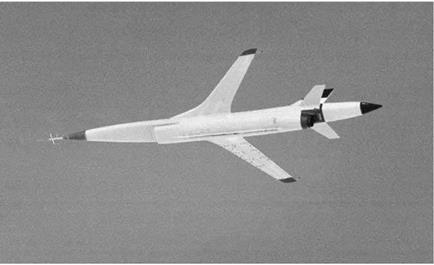Flutter: The Insidious Threat
The most dramatic interaction of airplane structure with aerodynamics is "flutter”: a dynamic, high-frequency oscillation of some part of the structure. Aeroelastic flutter is a rapid, self-excited motion, potentially destructive to aircraft structures and control surfaces. It has been a particularly persistent problem since invention of the cantilever monoplane at the end of the First World War. The monoplane lacked the "bridge truss” rigidity found in the redundant structure of the externally braced biplane and, as it consisted of a single surface unsupported except at the wing root, was prone to aerodynamic induced flutter. The simplest example of flutter is a free-floating, hinged control surface at the trailing edge of a wing, such as an aileron. The control surface will begin to oscillate (flap, like the trailing edge of a flag) as the speed increases. Eventually the motion will feed back through the hinge, into the structure, and the entire wing will vibrate and eventually self-destruct. A similar situation can develop on a single fixed aerodynamic surface, like a wing or tail surface. When aerodynamic forces and moments are applied to the surface, the structure will respond by twisting or bending
about its elastic axis. Depending on the relationship between the elastic axis of the structure and the axis of the applied forces and moments, the motion can become self-energizing and a divergent vibration—one increasing in both frequency and amplitude—can follow. The high frequency and very rapid divergence of flutter causes it to be one of the most feared, and potentially catastrophic, events that can occur on an aircraft. Accordingly, extensive detailed flutter analyses are performed during the design of most modern aircraft using mathematical models of the structure and the aerodynamics. Flight tests are usually performed by temporarily fitting the aircraft with a flutter generator. This consists of an oscillating mass, or small vane, which can be controlled and driven at different frequencies and amplitudes to force an aerodynamic surface to vibrate. Instrumentation monitors and measures the natural damping characteristics of the structure when the flutter generator is suddenly turned off. In this way, the flutter mathematical model (frequency and damping) can be validated at flight conditions below the point of critical divergence.
Traditionally, if flight tests show that flutter margins are insufficient, operational limits are imposed, or structural beef-ups might be accomplished for extreme cases. But as electronic flight control technology advances, the prospect exists for so-called "active” suppression of flutter by using rapid, computer-directed control surface deflections. In the 1970s, NASA Langley undertook the first tests of such a system, on a one-seventeenth scale model of a proposed Boeing Supersonic Transport (SST) design, in the Langley Transonic Dynamics Tunnel (TDT). Encouraged, Center researchers followed this with TDT tests of a stores flutter suppression system on the model of the Northrop YF-17, in concert with the Air Force Flight Dynamics Laboratory (AFFDL, now the Air Force Research Laboratory’s Air Vehicles Directorate), later implementing a similar program on the General Dynamics YF-16. Then, NASA DFRC researchers modified a Ryan Firebee drone with such a system. This program, Drones for Aerodynamic and Structural Testing (DAST), used a Ryan BQM-34 Firebee II, an uncrewed aerial vehicle, rather than an inhabited system, because of the obvious risk to the pilot for such an experiment.
The modified Firebee made two successful flights but then, in June 1980, crashed on its third flight. Postflight analysis showed that one of the software gains had been inadvertently set three times higher than planned, causing the airplane wing to flutter explosively right after launch
|
|
A Drones for Aerodynamic and Structural Testing (DAST) unpiloted structural test vehicle, derived from the Ryan Firebee, during a 1980 flight test. NASA.
from the B-52 mother ship. In spite of the accident, progress was made in the definition of various control laws that could be used in the future for control and suppression of flutter.[714] Overall, NASA research on active flutter suppression has been generally so encouraging that the fruits of it were applied to new aircraft designs, most notably in the "growth” version of the YF-17, the McDonnell-Douglas (now Boeing) F/A-18 Hornet strike fighter. It used an Active Oscillation Suppression (AOS) system to suppress flutter tendencies induced by its wing-mounted stores and wingtip Sidewinder missiles, inspired to a significant degree by earlier YF-17 and YF-16 Transonic Dynamics Tunnel testing.[715]











